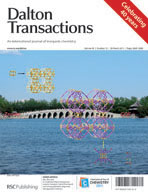Proton-induced reactivities of ruthenium azido complexes: the first example of boron–carbon bond formation by methylene insertion into a B–H bond†
Abstract
Whereas the reaction of Tp(PhCN)(PPh3)Ru–N3 {Tp = HB(pz)3, pz = pyrazolyl} with CH3I in CH2Cl2 led to the cationic ruthenium methyleneimine complex [Tp(PPh3)(PhCN)Ru(NH![[double bond, length as m-dash]](https://www.rsc.org/images/entities/char_e001.gif) CH2)]I, the analogous reaction with HCl gave rise to the ruthenium chloride complex containing a methyl tris(pyrazolyl)borate
CH2)]I, the analogous reaction with HCl gave rise to the ruthenium chloride complex containing a methyl tris(pyrazolyl)borate


 Please wait while we load your content...
Please wait while we load your content...